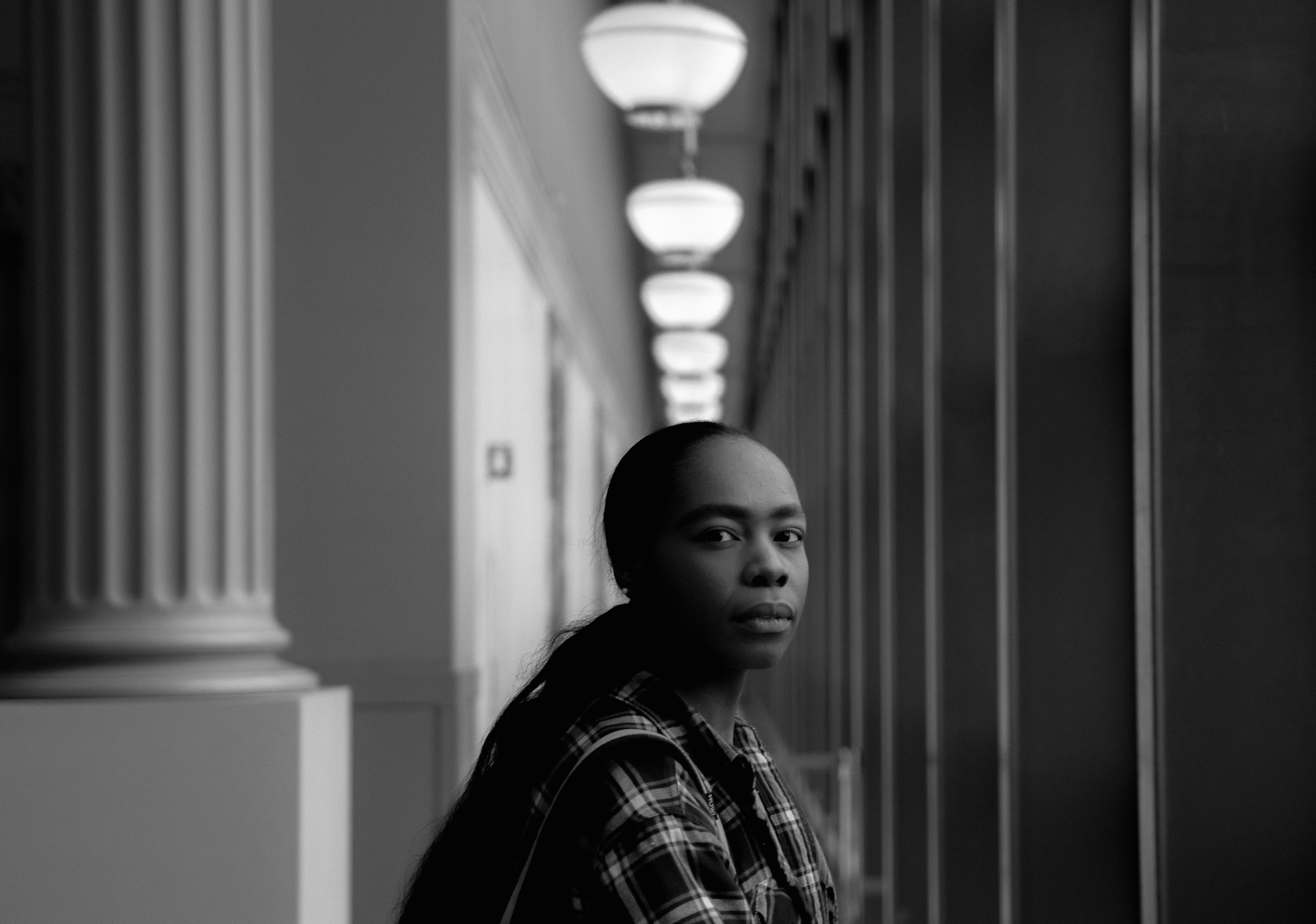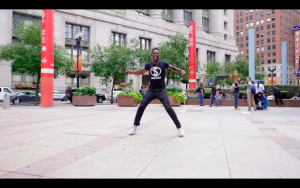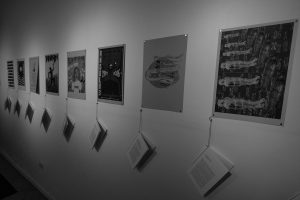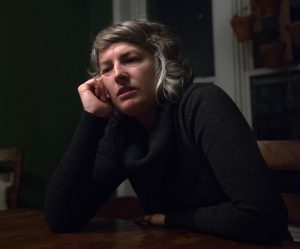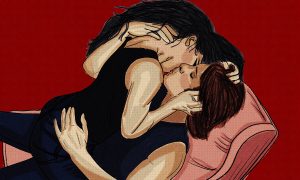bria royal is a 24-year-old multidisciplinary artist from the West side of Chicago. bria’s work often deals with Black and Indigenous mythologies, ecofeminism and futurist possibilities. In 2017, she released a graphic novel titled Black Girl Mania which fuses science fiction and personal narrative to follow a protagonist navigating mental illness in a post-climate change world’s last habitable land mass.
Most recently, she illustrated Missing Daddy, a children’s book written by one of Chicago’s most prominent organizers and prison abolitionists, Mariame Kaba. Kaba has had a hand in developing many of Chicago’s radical organizing projects, including Project NIA, Chicago Freedom School, Chicago Taskforce on Violence Against Girls and Young Women, Chicago Alliance to Free Marissa Alexander, and We Charge Genocide.
At Northwestern University, where she studied Communications, Film, and Psychology, bria helped form Unshackle NU, a political action group that pressured the school to divest from private prison corporations and companies that profit from the prison-industrial complex. As part of Unshackle NU, bria created an animated short called Prison-Industrial Complex 101. There she met Kaba, who was a guest speaker during the divestment campaign. They kept in contact, and Kaba supported bria’s later work as a founding member of For The People Artists Collective in 2016.
bria and Kaba first collaborated on a project called RJ Posters, a restorative justice poster project where, guided by Kaba’s questions, bria created a series of pocket zines focused on helping people practice transformative justice and process specific types of conflict, from arguments with roommates to facing larger forces of systemic oppression. After the zine project ended, Kaba contacted bria about a poem she’d written and was thinking of turning into a book. “Mariame just gave me so much frickin’ creative freedom in terms of developing the characters, adding characters, trying to figure out how I wanted them to look, what kind of representation I wanted this book to put out there for children’s media, things like that,” said bria. “Having that kind of trust was really a big part of how it came together.”
Myself and fellow Envisioning Justice resident Sebastián Hidalgo sat down with bria to talk about the ways in which healing from trauma is deferred until adulthood, radical healing through artmaking, and avoiding art’s co-optation by capital.
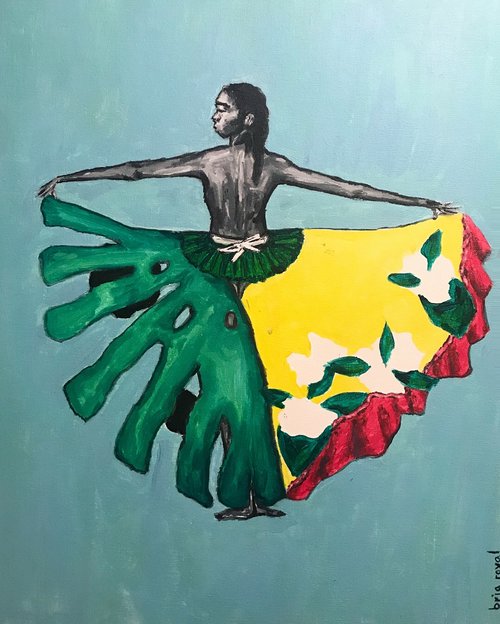
Jordan Sarti: Part of why I was really excited about interviewing you is I saw this really good tweet thread you wrote about the sort of artistic choices you made in Missing Daddy, and the color palette, and stuff like that, so I was wondering if you could talk a little bit about why those choices were important to you, and what your thought process was.
bria royal: Yeah. For me this was my first time really making trauma-informed children’s media. I’ve done a couple things with children before. Most of my work is aimed at a slightly older age group, but can work down, like, it may have innuendo that maybe children won’t get or something like that, but it can work its way down as well. And it made me really think about ageism, which is the ism that we don’t really list off when we’re listing off isms. And about healing rights. I’m really huge on healing as a right, and thinking of it in that way. People having the right to heal, as a basic human right. It’s a basic, like, human function, going through wear and tear and then healing oneself, bodily and mentally. All living things kind of go through wear and tear, and go through certain processes to try to heal themselves. And I think children are often left out of that conversation, as if they’re these passive beings, things just happen to them, and you’re not expected to deal with them until you’re an adult, and actually that’s really bad. You hear adults always talking about how so many issues have stemmed from childhood, and if not even directly stemming from childhood, stemming from systems that are put in place at a very very early age. I studied communications in college, amongst film and media and amongst psychology.
Sebastián Hidalgo: I mean, it’s very true, and if you look at, for example, the immigration ban, and separation of children from parents, that has such significant effects on a child’s upbringing.
br: Yeah. It’s such a critical point in a person’s life to instill certain values, in terms of their self-importance. So for me it was like, I need to be real careful with how I do this, just because it’s important. It’s a very impressionable age, and I think we think of being at an impressionable age as, like, this scary thing, but it’s also an incredible opportunity to introduce the change that we’re trying to see in the world. Yeah, I don’t know if there were specific points about the art you wanted to get into?
JS: Yeah, I mean, I guess I was interested in the color palette in particular, using warm tones, and wanting to create a safe space and feeling when you open the book and start reading it.
br: Yeah, yeah. I always use pretty much the same colors in all of my artwork, the same thirty colors in everything. They’re saved as a nice little Photoshop document, and I have a printout, so when I’m painting, I can reference the colors. I’m pretty anal about it. But I view my art making in general as a mode of feeling for myself, so I’m drawn to colors that inspire that feeling, that inspire that warmth, inspire certain aspects of my life that I feel the most free in. I use a lot of greens, because I’m a big proponent of making sure that nature and how we think of nature as like, plants, and our environment as something beyond, just like, humans, makes it into our visions of the future, because I do a lot of futurist work. So I’m always making sure I have greens, and browns, and earth tones in there. Just kind of paying my respects to the earth’s existence and like, future existence.
But also I don’t use, like, a white background. It’s very rare that I use just a plain white background for any of my art, because it just instantly puts you in a mood. When I was younger, I would do a lot of painting on cardboard boxes and manila folders, and pretty much anything I could just get my hands on that was cheap, and those surfaces kind of hold paint a little better than just regular paper if you don’t have access to canvases and things like that. And even, like, being a kid and playing in boxes a lot was something I did. I don’t know. I’m thinking of it now like, in terms of growing up in poverty, was really important to me growing in imagination, kind of. So I always kind of see that as my default canvas. And it’s also just kind of easier to get started when you’re not just looking into emptiness, if that makes sense. Starting with like, a wash.
Each of the characters has a highlight color, and I kind of thought, well, one of the first lines in the poem, when Mariame first sent it to me, talked about the main character as this lightning bug to her dad. I really latched on strong to that point. I think probably, like, in a way that Mariame wasn’t expecting, even, it was kind of just a reference. But the thing about lightning bugs is, like, it’s that light in the dark. It’s this magical light in the dark, on a summer night anyone can see, it’s this very magical thing that’s very accessible to a lot of people. That idea of a light in the dark kind of just stuck with me. And I wanted this character to embody a color that was pretty bright. They’re pretty neon colors in the book. I didn’t want it to just be all flat and warm, I wanted to be, like, through those specks of brightness.
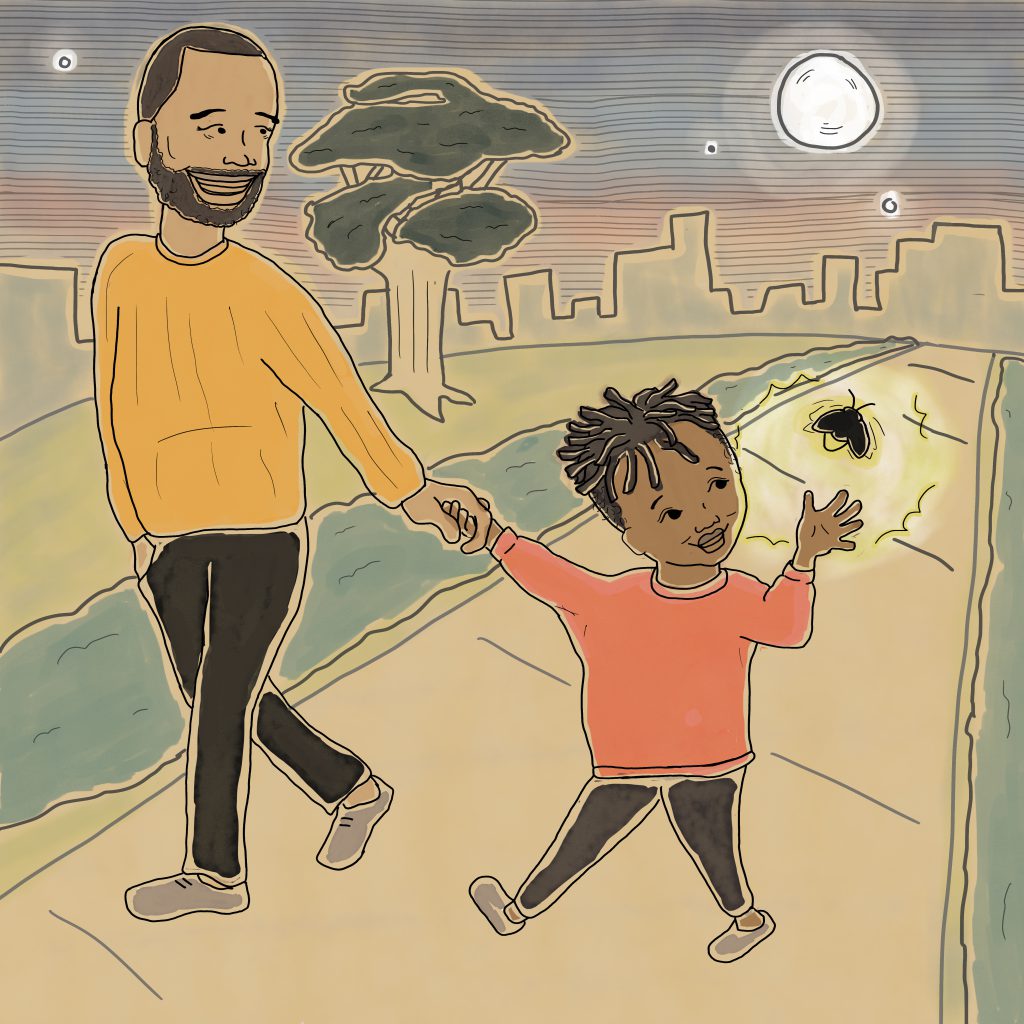
JS: I think the question of how to speak to children about really heavy things using art is really important. I’m thinking too about how a lot of organizing movements want to bring children into the organizing they do and make them a meaningful part of it, and a lot of how they do that is through art. Having kids make art for like, banners. So that’s kind of an interesting element too, making art for children, and kind of wanting them to be part of the conversation through visuals.
br: Yeah. It’s not just the children, too. It’s also whatever adult is introducing this book to them. I think people in general, art kinda sweet-talks you in in many ways, to a lot of difficult topics to address. Black Girl Mania talks a lot about bipolar disorder, and certain other, institutionalization of like, science, and how that disadvantages poor people, and environmentalism, and things like that. But it’s a comic. You don’t typically think of addressing those topics in a comic form if you’re not very familiar with the medium. It’s kind of similar with this. You don’t necessarily think a picture book of incarceration. But I’ve always tried to use art as a way of kind of getting people’s attention on issues that they may not feel as comfortable talking about. That are uncomfortable to talk about. It’s hard. But I think art works as a pretty good icebreaker. There’s almost a romanticism about it in the way that art can pull people in to even consider talking about certain things, you know? So that’s something I definitely saw the opportunity to do when Mariame reached out to me for the book.
SH: That’s amazing. That’s very, very hard to do. Yeah.
JS: This is kind of related, but I think a lot of people have this sense that some topics are too dark or heavy to talk about with younger people. So I guess, like, that obviously seems problematic, because some young people are just going through it, they can’t help it. But how do you think we can get better at those kinds of conversations and being able to reach young people?
br: Yeah. I think one, we have to also recognize this is something we have a hard time talking about it just to ourselves as well. So I think it starts with that as well. But I think it’s just like, recognizing that young people are already experiencing it. So they deserve to have healing around it too. You’re not too young to experience the pain of incarceration, but you’re too young to talk about it? You’re too young to try to heal from it? I think that’s just kind of a logical fallacy, almost in a way. It takes care. It takes an immense amount of care and resources that I think schools are often under-equipped with. So there’s the whole, like, system of support that has to be in place for helping not re-traumatize, or further traumatize, a young person.
But I think this notion that we must preserve the ignorance of youth for the sake of some goodness, is not working. And there’s several places I think, looking back on my life, where I wish someone would have explained that to me when I was younger. You have a young person who just feels bad and doesn’t know why. And they often don’t get that answer, or it takes immense amounts of resources that are often inaccessible, like therapy, or things like that, to get back to that.
I want young people to be able to pick this up on their own, but I also want people to read it together. And have conversations after, you know. I always think of art kind of as a conversation-starter. But I think it’s important as artists that that conversation be somewhat guided. So that’s why there’s a discussion guide, you know, ’cause as artists you see art get out of context very quickly and it can become a very dangerous thing. I think as an artist taking that extra step is, like, making sure your work is highly contextual, if you’re trying to really say something, you know. Not just be a conversation starter, but have an action item in mind. What are you trying to move people toward in their conversation?
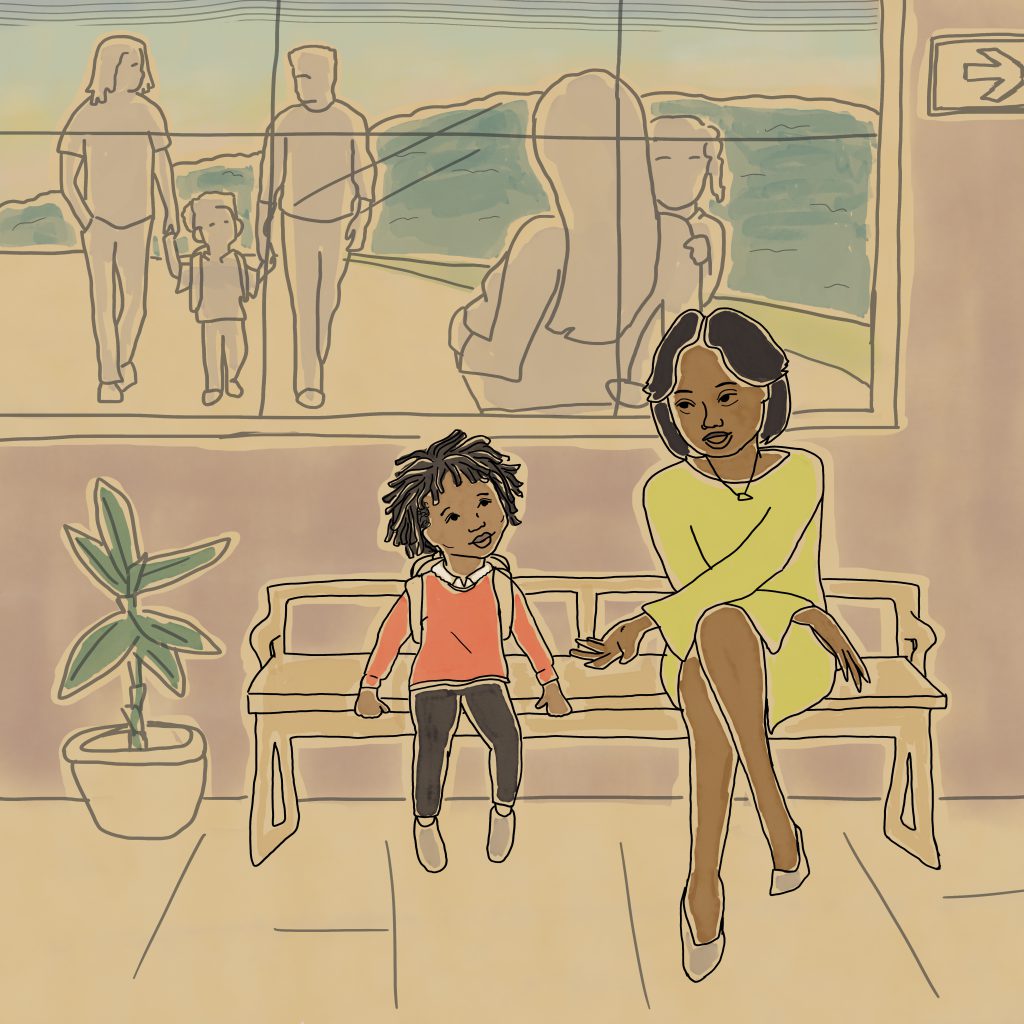
SH: I feel like we need to have these conversations in order to heal, which is ultimately what you’re trying to do. Is there any plan to introduce this to a restorative justice practice for young people?
br: Yeah. So many people, in the time it’s been released already, have reached out to share stories about how they shared it with their family members, their young family members, or in their schools. Just seeing teachers, in particular, being really enthusiastic about having the book as a resource, has been really good. It’s been great to see, and I’m glad that, like, that enthusiasm is there. I feel like so much of feedback has been, “I can’t believe something like this hasn’t existed before, or I haven’t heard about something like this before.” There’s enthusiasm to build curriculum around these topics, and I’m like, all right! Let’s keep supplying it, as artists. Let’s keep supplying those resources, then.
SH: That’s amazing.
JS: This is kind of switching gears a little bit, but I was really interested in something I read on your website, you talked about how you consider your work a result of radical healing processes. It made me think about the program that we’re assigned to, Just Art, this art class in a space that is very not conducive to making art and thinking about making art being this action that has some healing properties, or healing value, in itself. I was kind of wondering how you thought about your own radical healing, if making art is a part of that, or if you think art has inherently healing elements to it.
br: Yeah. For sure. It’s kind of a two-part thing. So one, yes, my art making began as just something I would do to, I don’t know, create almost these parallel universes for myself that were fictional, right, but are still very parallel to my experiences, where I could feel safe processing trauma that I’ve experienced in my life, and try to recover from it, through that. I feel like it’s hardest to admit things to yourself. Once you admit things to yourself, it’s easier to kind of address it with other people, but recognizing you have been harmed, or recognizing the ways you have been systematically traumatized, like, that can be, in itself, very unsettling for a person.
And I guess my coping mechanism for that was to create these parallel universes through my art, where I could even just talk about these things. It’s almost like projecting. Projecting my mental health issues onto a character with a different name, and exploring certain scenarios that I’ve experienced in my own life, but through this character. Seeing how they play out this way, how they play out that way, was a good way for me to just get myself comfortable with healing. Because it’s very uncomfortable, it’s awkward. It’s, like, some awkward shit. So that’s kind of my sneak attack strategy on myself, like, let me create this fictional world, but put very real systems that I experience in my life inside of it. And then just keep asking a bunch of what-if questions from there. And seeing how things play out. I played a lot of Sims when I was younger, do y’all know that game?
SH: Wait, which game?
br: The Sims. It’s like, you can play out different scenarios. I feel like that’s kind of where I got that idea from. And, yeah, it was very productive.
SH: How did you get money in The Sims? Did you move into somebody’s house and kick everybody out and get their money?
JS: I got the cheat code, so you can just produce infinite money.
SH: I did it the really weird way, where you just locked everybody in the basement, took their money, and left.
br: You’re one of those Sims.
SH: Yeah. [laughs]
JS: I feel like so many artists would cite Sims as one of their major influences.
br: It’s a dollhouse. It’s fun.
SH: It’s very interesting, to the point that you just proved to yourself, or to us, right. When you’re talking I keep imagining this cardboard canvas, and you’re painting over it, and how what you’re doing now is a result from that. Creating an alternate world, with a different name, but with your experiences.
br: Yeah. And even just like, I talk a lot about catastrophic fears. Catastrophic fears are just things that you irrationally fear. Things that are very low-probability to happen to you, but that you intensely fear.
For example, one of my catastrophic fears is that the earth is completely flooded because of global warming, and there won’t be any land left for anyone to be on. We’ll just be in this water world. I also have this thought in my mind that land is what holds the earth together, even though I know that’s not true, it’s, like, just gravity. But in my mind, if the world is completely filled with water, it’s just gonna fall apart. Like, yeah. Random catastrophic fears, but there is an underlying environmental anxiety attached to that. So in Black Girl Mania, I was just like, okay, what if the world literally flooded like that?
The premise of Black Girl Mania is that the only land left in the world is the size of Puerto Rico and there’s a lot of sociopolitical things around who has access to land and who doesn’t. You just keep asking yourself, you take your catastrophic fear, and say, what is that? Maybe it would be like this, maybe this would be like this, and it becomes a more manageable fear, almost. And that process of imagination has been super healthy for me in just like, managing anxiety, things like that.
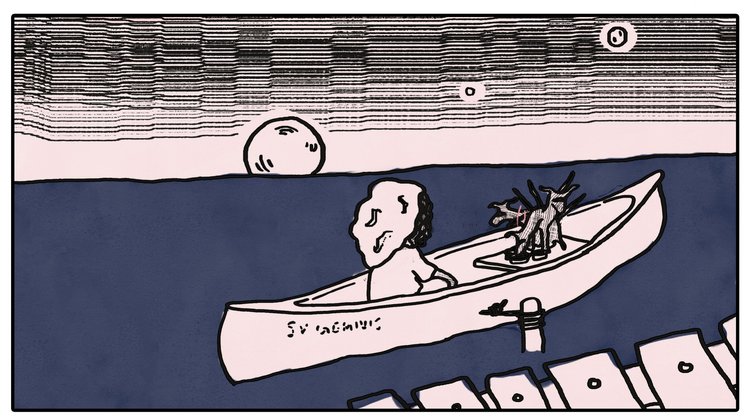
JS: Yeah, it’s interesting that you go to, like, dystopia for anxiety management, because other people would maybe think about utopian possibilities. But realizing dystopia can make you feel freer in a way, too…
br: Imagining an unattainable utopia, to me, is hella stressful. I can’t just imagine my perfect world and just go there. I’m never gonna get there. Like, that’s what I’m gonna feel like. That’s not a hopeful visualization for me. And I know that’s where a lot of like, for example, certain mindfulness therapy techniques and cognitive-behavioral therapy, really zone in on you finding a utopia in your mind and taking little vacations there. But for me, yeah, I kind of find my solace in the dystopia. For some strange reason, ’cause it’s like, if I can imagine struggle and fight and change even in that environment, then I’m like, all right, we can do some shit here, you know?
JS: People still exist in this world.
br: Yeah.
JS: Um, so, yeah, I guess my next question is kind of bringing it back to Envisioning Justice. How can art be useful in social justice movements, and not just, kind of– I guess you touched on this, it shouldn’t be able to be taken out of context or co-opted. What are your thoughts about art’s role in social justice movements?
br: Yeah. Before moving to that question, I’ll just say, my caveat to your previous question was that I’ve gotten very good at recognizing when I’m making art and it’s not healing, and it’s just work, maybe. Some days it’s just work, you know. Being able to be comfortable with that, because I feel like some artists think their art always has to be healing, and it’s like, you can actually enjoy doing something and it doesn’t necessarily bring you the most spiritual experience with your art or whatever. It could just be mindless doodling. But making sure that you then do find something else to bring you that same kind of feeling of healing. So I’ve gotten better at, when I’m going through a phase where like, this art is work, making sure I plug in some other act of healing.
JS: If you have to heal every day from nine to five that’s probably not going to be healthy.
br: Yeah. That’s just putting too much pressure on yourself, “why am I not healing?” But yeah. Art’s role in social justice movements, I think the last few years, the importance of art in just getting people’s attention on certain social justice movements has really increased, and I think it’s probably thanks to our increasingly media-driven and digitally accessible society, our digital public and the way art functions as a very, very key social asset in our digital public. You have our physical public that we’re in right now, but our digital public, like our social media platforms and things like that, are so much more obviously art-influenced, and more accessible. I can post something that someone across the country or across the world can see. And also something that, you know, digitally, has proven this very eternal life expectancy that maybe a painting of mine doesn’t have, you know? But yeah, I think we’re finally starting to realize that the way that big media has used art, like, we also have that power. We also have the power to change people’s minds through art in a very grand and large-scale way.
At least in Chicago, I’ve definitely seen a shift where it’s not just like, oh, we have an event, and art is the afterthought. It’s more in the planning phase of things, people see it as a critical part of the campaign: the look. With that we do run the risk of adopting some of the things that these big media and advertisers do that maybe we don’t want in our spaces, which is the risk of sensationalization, making movements too sexy. I don’t know. I think movements being sexy and attractive is a great thing. But it also undoubtedly invites capitalism, it undoubtedly invites some of these systems that we’re actually trying to tear down to profit from us in ways that can be very dangerous. And I think we’re starting to see that nuance a lot lately, even with the rise of like, activists as personalities on Twitter. Or art as like, a thing that’s associated with gentrification, in Chicago and many other cities. You see the artsy community is always the first place hit, and it’s because it’s sexy, it makes it sexy, right?
SH: That’s pretty true.
br: But I think so long as those people become accomplices, instead of simply replicating, like, capitalism in the artistic form, even though the content is right, the content is about seeking justice. I think that’s something people have to be very wary of, and if we can keep that accomplice state of mind within our viewers or readers or listeners, our position here can have a lot of power, to have access to a lot of power that was previously inaccessible without money tied to it, or without, just like, bureaucracy tied to it.
JS: So what other projects are you working on right now?
br: What other projects am I working on? Well, I’m working on two short films at the moment, both are animated short films. I can tell you the name of one of them, it’s called Tectonic, and actually it takes place here in Chicago. It’s about kind of a community of these fierce people who embody motherhood in various ways, who are for their own separate reasons facing displacement, they’re kind of like being forced to relocate, being evicted, things like that. For whatever reasons. A small community led by the main character, who finds refuge in the middle of Lake Michigan. In this kind of like, Afrofuturist setting. Basically, plate tectonics, I’m obsessed with the geology of the earth and things like that. But it leads to a new land mass kind of popping up in the middle of the lake. And there comes kind of a race between this radical squad of mothers and the city, to kind of see who gets there first. For me it represents kind of the notion that the lake, or the earth, is on our side in struggle. That the exploitation that we face also the earth faces, and that…
SH: Like Indigenous practices about being one with the earth because the earth is one with us.
br: Yeah. And the system of capitalism that we’re struggling under is harming both of us in these very powerful ways. So it’s kind of a little alliance. It’s a story of a little alliance between the earth and these mothers, and kind of addressing that. It’ll be out, like, probably by the end of winter, early next year.
This article is published as part of Envisioning Justice, a 19-month initiative presented by Illinois Humanities that looks into how Chicagoans and Chicago artists respond to the the impact of incarceration in local communities and how the arts and humanities are used to devise strategies for lessening this impact.
Featured Image: Black-and-white portrait of bria royal in semi-profile, flanked on either side by columns and beams. Above her head are a series of globular light fixtures. Photo by Sebastián Hidalgo.

Jordan Sarti is a writer and journalist in Chicago. Her writing has appeared in In These Times, HYSTERIA, Temporary Art Review and Slutist. Right now, she is thinking about body politics, carceral capitalism, and plants. In her spare time she invents increasingly intricate ways to rest.
